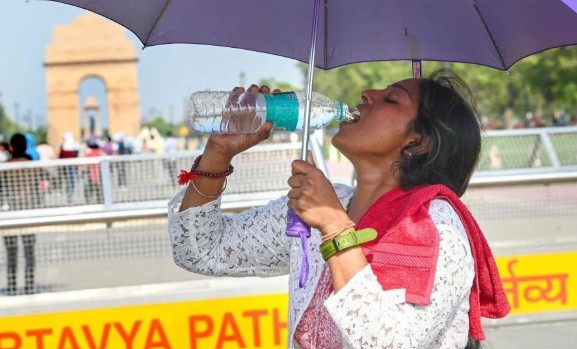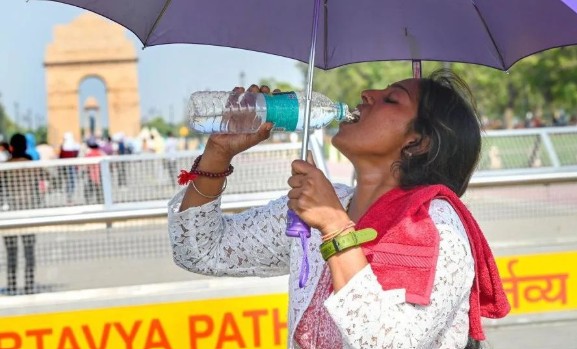North India Grapples with Unprecedented Heatwaves: A Deep Dive into a Growing Crisis
North India is currently in the throes of an intense and prolonged heatwave, a recurring annual phenomenon that is becoming increasingly severe and arriving earlier with each passing year. As temperatures soar to record highs, impacting millions, understanding the multifaceted nature of this crisis is crucial for effective mitigation and adaptation.

The Scorching Reality: Defining and Experiencing the Heatwave
A heatwave in India is officially declared when the maximum temperature of a station reaches at least 40°C or more for plains, or 30°C or more for hilly regions, with a departure from normal of 4.5∘C to 6.4∘C. A “severe heatwave” is marked by a departure of more than 6.4∘C or an actual maximum temperature exceeding 47∘C. The current situation in North India is pushing these thresholds, with cities like Delhi, Jaipur, and even traditionally drier areas like parts of Rajasthan experiencing temperatures significantly above seasonal averages. Some areas in North India have seen temperatures in excess of 45∘C, with some individual stations even reporting over 50∘C in recent years, though some such readings have been attributed to sensor errors.
While May and June are historically the hottest months, the disconcerting trend is the early onset of these extreme conditions, often beginning as early as March. This shrinking spring season means a quicker transition from winter to intense summer, leaving little time for preparation and acclimatization.
The Driving Forces: Why is North India So Hot?
Several factors contribute to the escalating heatwave crisis in North India:
- Climate Change: A significant and undeniable driver is human-induced climate change. Studies, including analyses by organizations like ClimaMeter, reveal that recent heatwaves are occurring in an atmosphere that is several degrees warmer than similar events in the past. This global warming fundamentally alters weather patterns, making extreme heat events more frequent, intense, and prolonged.
- Urban Heat Island Effect: Rapid urbanization, particularly in densely populated cities like Delhi, Mumbai, and Jaipur, exacerbates the heat. Concrete structures, asphalt roads, and limited green cover absorb and retain heat during the day, releasing it slowly at night, leading to higher nighttime temperatures. This prevents the body from recovering from daytime heat, amplifying health risks.
- Reduced Western Disturbances: A decrease in the frequency and intensity of Western Disturbances, which bring rainfall and cooler temperatures during the pre-monsoon season, contributes to drier conditions and uninterrupted heat build-up.
- Increased Humidity: A worrying trend observed in North India is a significant increase in relative humidity, particularly in the Indo-Gangetic Plain. While temperatures soar, high humidity hinders the body’s natural cooling mechanism through sweating, leading to greater heat stress and health complications.
- Delayed Monsoon: The arrival of the life-giving Southwest Monsoon, which typically brings relief from the heat, can sometimes be delayed or experience “hiatus days,” prolonging the scorching conditions. While the monsoon usually covers most of India by late June and Delhi by June 27th, any deviation can mean extended periods of severe heat.
The Devastating Impacts: Beyond Discomfort
The consequences of these relentless heatwaves are far-reaching and severe, affecting various facets of life:
- Public Health Crisis: Heatwaves pose a significant threat to human health. Dehydration, heat cramps, heat exhaustion, and potentially fatal heatstroke are common. Vulnerable populations, including the elderly, infants, outdoor workers, and those with pre-existing medical conditions, are at the highest risk. Hospitals report a surge in heat-related illnesses, including digestive problems like diarrhea and nausea as the body diverts blood to the skin for thermoregulation, hindering digestion.
- Agricultural Distress: Crops are highly susceptible to early-season heat stress, leading to reduced yields and significant economic losses for farmers. This impacts food security and the livelihoods of a large segment of the population.
- Infrastructure Strain: The soaring temperatures put immense pressure on power grids, leading to increased demand for electricity for cooling and subsequent widespread outages. Water resources are also severely strained, with increased groundwater extraction further depleting already stressed aquifers.
- Economic Productivity Loss: Extreme heat directly impacts labor productivity, especially for outdoor workers in sectors like construction and agriculture. This can lead to substantial economic losses, with projections indicating a significant reduction in India’s GDP by 2030 due to heat stress.
- Environmental Degradation: The dry conditions associated with heatwaves increase the risk of wildfires, impacting ecosystems and air quality.

Towards Resilience: Strategies for Mitigation and Adaptation
Addressing North India’s heatwave crisis requires a multi-pronged approach, encompassing both immediate relief measures and long-term climate action:
- Early Warning Systems and Public Awareness: The India Meteorological Department (IMD) plays a crucial role in issuing timely heatwave alerts, forecasts, and advisories. Disseminating this information widely through various channels, including mobile apps and social media, is essential for public preparedness.
- Heat Action Plans (HAPs): Many states prone to heatwaves have implemented HAPs, which include measures like establishing cooling shelters, ensuring access to water, and advising on safe practices during peak heat hours. These plans need to be robust, localized, and effectively implemented.
- Urban Planning and “Smart Surfaces”: Cities must prioritize sustainable urban planning. This includes:
- Increasing Green Cover: Planting more trees and creating urban forests helps reduce ambient temperatures through shade and evapotranspiration.
- Cool Roofs and Reflective Pavements: Using light-colored, reflective materials on roofs and pavements can significantly reduce heat absorption in urban areas.
- Permeable Paving: This helps in managing stormwater and can contribute to localized cooling.
- Climate-Resilient Building Design: Promoting passive cooling techniques in new constructions, such as proper ventilation, shaded windows, and insulation, reduces reliance on energy-intensive air conditioning.
- Protecting Vulnerable Workers: Implementing policies to protect outdoor workers, such as adjusting work hours, providing shaded rest areas, ensuring adequate hydration, and offering light-colored clothing, is critical.
- Water Conservation and Management: Efficient water management strategies, including rainwater harvesting and reducing water wastage, are vital to cope with increased demand during heatwaves.
- Addressing Root Causes: Ultimately, mitigating the long-term impact of heatwaves requires a global commitment to reducing greenhouse gas emissions, transitioning to renewable energy sources, and promoting sustainable practices across all sectors, aligning with international agreements like the IPCC’s recommendations.
The heatwave gripping North India is a stark reminder of the escalating climate crisis. While immediate relief efforts are paramount, a holistic and proactive approach focusing on both adaptation to the current realities and ambitious mitigation of future warming is the only way to safeguard lives, livelihoods, and the environment in this increasingly hot region.

